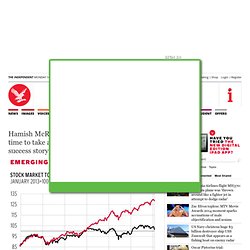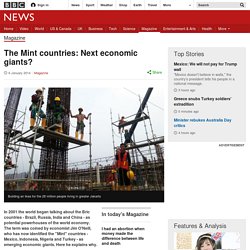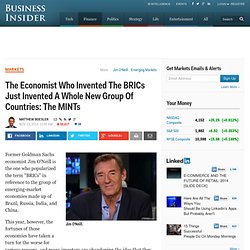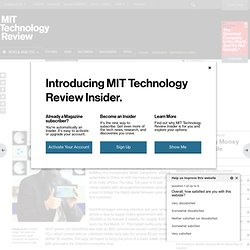

Kickstarter economics 101: How much should you charge for a Backer Reward? I spend quite a bit of time supporting, looking at (and running my own) Kickstarter campaigns.

One of the things I often notice is that some people don’t really think about what their campaign is for: funding their project. I’ve seen people who have promised hand-painted postcards for their Kickstarter backers at $15. The problem with this is that the postcards weren’t core to the Kickstarter project, so in practice, every second spent on those postcards was a second not spent on the main project. So what would happen if this person received 200 backers for that award level? That would be amazing! Hamish McRae: From the Brics to the Mints, is it time to take a new look at the emerging markets' success story? - Hamish McRae - Business Comment. Except that it didn't turn out like that.

If you take as your benchmark the performance of equities, last year was a bit of a disaster for this strategy. As you can see from the graph, 2013 was the year when emerging markets moved sideways while developed markets shot ahead. Is the great emerging market run over? Some of its previous enthusiasts think so. For example, last month Goldman Sachs's investment management division told clients to cut their emerging market exposure by one-third, from 9 to 6 per cent of their total portfolios.
Others broadly agree. BRIC-layer makes MINT. Former Goldman Sachs economist Jim O’Neill, deviser of the BRIC acronym uniting the emerging market giants of Brazil, Russia, India and China, has coined a new term – MINT.

The Mint countries: Next economic giants? In 2001 the world began talking about the Bric countries - Brazil, Russia, India and China - as potential powerhouses of the world economy.

The term was coined by economist Jim O'Neill, who has now identified the "Mint" countries - Mexico, Indonesia, Nigeria and Turkey - as emerging economic giants. Here he explains why. So what is it about the so-called Mint countries that makes them so special? Why these four countries? A friend who has followed the Bric story noted sardonically that they are probably "fresher" than the Brics. This is the envy of many developed countries but also two of the Bric countries, China and Russia. Something else three of them share, which Mexican Foreign Minister Jose Antonio Meade Kuribrena pointed out to me, is that they all have geographical positions that should be an advantage as patterns of world trade change. Bye-bye Bric, hello Mint — are Mexico, Indonesia, Nigeria and Turkey really the new boom economies? Plus: Why there's so little space on your local war memorial for the names of World War II heroes New year new ideas as we woke up on Monday morning to find ourselves in Lagos with Evan Davies trying to convince us that Nigeria really is undergoing an economic earthquake.

It’s part of a week-long campaign by Radio 4 to make us believe that the next economic leaders among world nations will be Mexico, Indonesia, Nigeria, Turkey. These new Mint countries are destined, we are told, to take over from the Bric countries, now deemed passé after just a decade in the limelight generated by the economist fashionistas. It’s stimulating stuff for this hibernating time of year. Bulletins and programmes high on optimism and imbued with the belief that in certain parts of the world at least poverty is being overtaken by progress while corruption is being suppressed by a mixture of creative enterprise and demographic reality.
Evan was not his usual enthusiastic self. Jim O'Neill Presents The MINT Economies. Former Goldman Sachs economist Jim O'Neill is the one who popularized the term "BRICs" in reference to the group of emerging-market economies made up of Brazil, Russia, India, and China.

This year, however, the fortunes of those economies have taken a turn for the worse for various reasons, and many investors are abandoning the idea that they will be able to continue the rapid growth that has characterized the past several years. Much investor attention has therefore shifted from emerging markets to "frontier markets," a classification made up of economies smaller than those of the BRICs.
In a new column for Bloomberg View, O'Neill presents a new potential investment destination: the "MINT" economies (emphasis added): I spent last week in Indonesia, working on a series for BBC Radio about four of the world’s most populous non-BRIC emerging economies. The BRIC countries -- Brazil, Russia, India and China -- are already closely watched. After The BRICS Are The MINTs, But Can You Make Any Money From Them? Millennial Entrepreneurs Harness Power of Vintage Train Travel. Two dozen young entrepreneurs spilled off a train exhausted after their journey and dragged their luggage toward Washington, D.C.’s bustling Union Station.

The Millennial Trains Project participants had just spent a week and a half chugging cross-country in vintage train cars as part of what amounted to a moving start-up incubator. Each young entrepreneur had an idea for a project that could have broad impact but be implemented at the local level and they helped each other breath life into those ideas as they rolled across the country. DataWind’s Aakash 2 and Ubislate Are Cheap Tablets for the Developing World. A devout Sikh, Suneet Singh Tuli, 44, has found his own way to live by his religion’s central belief of sarbat da bhala, or “may everyone be blessed.”

He wants everyone in India to be on the Internet. To that end, Tuli’s London company, DataWind, is building very inexpensive tablet computers, which it assembles in China or with the help of support staff at its India offices. The idea, Tuli says, is to pair cheap tablets with ad-supported wireless service as a way to bridge the digital divide between poor and rich countries. DataWind began winning attention last year when it struck a deal to supply India’s government with 100,000 of its Aakash 2 tablets, for roughly $40 each, by this March 31. That tablet works only near Wi-Fi points, but DataWind also sells an $83 commercial version called Ubislate 7C+, which comes with an unlimited mobile data plan for around $2 per month.
Nanoscribe claims world’s fastest commercially available nano-3D printer title. Smart Education: How Lynda.com Hit $70M In Revenue Without A Penny From Investors. As Ned Flanders would say, education in the U.S. is in “a dilly of a pickle.”

At the risk of sounding like a broken record, the cost of education has become unsustainable. Student loan debt is over $1 trillion, unemployment remains high for the recently graduated, and non-traditional students — older people, single mothers, workers looking to re-train — are returning to academia and learning programs in droves, putting even more competitive pressure on already-scant on-site resources.
Higher ed institutions struggle with the cost of expanding to meet demand.